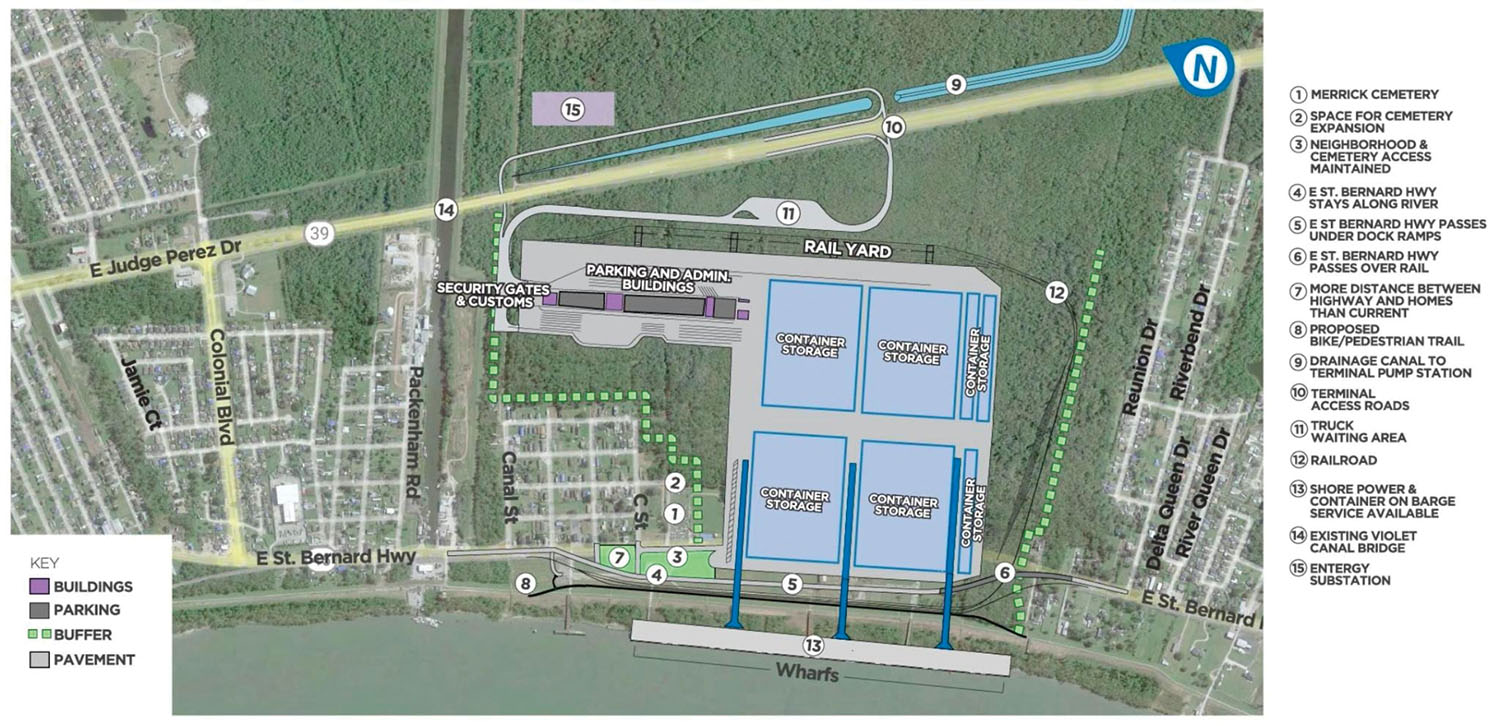The Port of New Orleans (Port NOLA) has announced updates to infrastructure and the overall design of its planned container terminal to be built in Violet, La., within the parish of St. Bernard, downriver from New Orleans. The updates were made with an eye toward sustainability and in response to input from the surrounding community.
Since announcing plans to build the Louisiana International Terminal in St. Bernard Parish—and since acquiring the real estate for the project—the port has held a series of community meetings and has sought public input on the overall design and other concerns for the project.
“One of the benefits of building a new terminal from the ground up is that we can implement the latest advances in green technologies,” said Brandy Christian, president and CEO of the Port of New Orleans. “And with air quality and noise common concerns that came up in our community outreach, I’m pleased to share our partners’ early commitments to sustainability.”
The new terminal will have shore power, which will allow vessels to connect to the onshore power grid and, thus, turn off diesel engines while at dock. According to the port, up to 98 percent of ship-related emissions can be eliminated by using shore power. The port also expects the yet-to-be-announced terminal operators to employ a predominantly electric fleet of equipment. To meet that need for electricity, Port NOLA is working with Entergy Louisiana to place a substation on site. The terminal will also be optimized for growing container-on-barge services, which will help divert traffic from road and rail to the Mississippi River.
Port NOLA also announced some roadway news related to the new terminal. Port officials are working with the state to study, fund and build a new roadway connecting lower St. Bernard Parish—and the terminal—to I-10, thus ensuring that truck traffic going to and from the port stays predominantly off of existing roads. The planned roadway has received a $50 million commitment in funding from the Louisiana state legislature, with $2 million in funds just released to pay for a feasibility study.
In addition, the port has announced that the updated layout of the terminal will allow St. Bernard Highway, which runs along the river through the parish, to remain close to its existing location. The new layout also includes larger buffers between the terminal and neighborhoods, adds an overpass for cars over a rail crossing, sets aside space for a local cemetery to expand and allows for a bike and pedestrian path along the levee. The plan now also includes a system of pumps, canals and a pumping station to be managed by the port, all in response to public concerns.
“The input we received over the past two years from conversations at our community office, our two Community Advisory Councils, three public open houses and during two 30-day public notice periods gave us valuable insight,” Christian said. “We are listening, and we will continue to ask for feedback in order to deliver a project that provides opportunity and protects quality of life.”
“The Violet community has a seat at the table with the planning of this project,” said Kevin Gabriel, a local pastor, Community Advisory Council member and president of the St. Bernard NAACP. “I’m supporting the port because it’s going to bring jobs, a new school and a space for our cemetery to expand.”
Port and regional economic development officials say the state must have a new container terminal downriver from the Crescent Connection bridge, free of air-draft restrictions, in order to compete with other terminals in the region, like the Port of Mobile. Without a new container terminal, the state could lose close to 10,000 existing jobs and $10 billion in output in a decade, according to a study by economist Dek Terrell.
“Not only does container shipping deliver goods to our grocery stores and packages to our doorsteps, but it’s also how Louisiana manufacturers and agricultural producers get their products to market,” Christian said. “If our state is to remain in the container shipping business—and to retain exports and grow imports—we must build the Louisiana International Terminal.”
Michael Hecht, president and CEO of Greater New Orleans Inc., echoed that imperative.
“The Port of New Orleans has long been a key driver of our regional and national economy, supporting thousands of jobs,” Hecht said. “The Louisiana International Terminal is vital to ensuring that our region remains a global logistical hub. What’s more, the investments made by the Port of New Orleans will provide well-paying jobs and drive tax revenue across St. Bernard Parish and the region.”
The project is at the beginning of the federal permitting process, which is required by the National Environmental Policy Act and overseen by the U.S. Army Corps of Engineers. At the same time, port officials say they are finalizing negotiations with ocean carriers and terminal operators who will invest in the project. The port hopes to begin construction on the terminal in 2025, with the first berth opening in 2028. The port estimates the project will create more than 17,000 new direct and indirect jobs, $1 billion in new tax revenue for the state, $470 million to St. Bernard Parish and a 15 percent increase in personal income in the parish by 2050.
“Our state’s future rests in competing in a global market,” Christian said. “So, we must invest in a trade-based economy. We must invest like our Southern-state neighbors or get left behind. And if we do it right, we have the opportunity to be the next generation leader in global trade.”
Caption for graphic: Port of New Orleans map of proposed Louisiana International Terminal. (Click on image for full map.)



